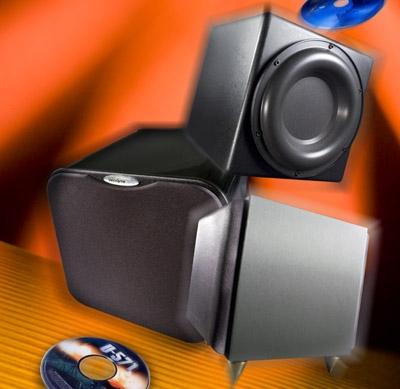Tiny Killer Subs

What's big and black, rumbles a lot, and can go really, really deep? If you said "a submarine," you're right. If you said "a subwoofer," you're half right. Both kinds of subs can take you down into regions you've never been to before - and a subwoofer can do it without a nuclear generator, cramped quarters, and the possibility you'll never see daylight again. But unlike their nautical counterparts, subwoofers don't have to be big anymore to explore the lowest depths - a point well illustrated by the three models here.
Sunfire pretty much revolutionized the subwoofer world in 1999 with its 9-inch-tall True Subwoofer Junior, and the True Subwoofer Super Junior ($995) follows in that "less is more" tradition. Veldodyne - which has long been synonymous with topnotch subs - offers up the $999 SPL-800R. And Pinnacle has the smallest entry here, the 8-inch-high SubSonic ($699). None of these subs can drop a depth charge or fire a torpedo, but all three can make you feel like your house has just been hit by one. And they do it with true action-movie flair, while lurking out of sight in a dark corner of your home theater.
Why the big push toward little subs? To anyone but a serious A/V enthusiast, there is nothing beautiful about a great, hulking cabinet in the family room, and placing one there has caused more than a little discord in many homes. So it's no surprise manufacturers have developed ever smaller subs that can disappear into their environments, or that they've tried to wring performance from them that's on par with their larger counterparts.
But getting a small box to put out deep bass isn't an engineering slam-dunk. The laws of physics say you need to excite large sound waves to create bass, and the easiest way to do that is to use big drivers in big cabinets. There's more than one way to skin this particular cat, though, and it usually comes down to employing shock-and-awe quantities of power, super-long-throw drivers, and generous equalization.
Those are the methods employed by our scofflaws here, the largest of which is hardly bigger than the box your kid's league-approved soccer ball came in. Yet any of them can deliver enough deep bass (under most circumstances) to satisfy even experienced listeners - and to knock their socks off when the source is revealed.
What qualifies as "deep bass?" In my book it's sound that goes substantially below 40 Hz. That's the region of the lowest bass notes and subsonic rumbles - the kind you can feel but not hear. The sub needs to play loud enough to compete with the rest of the speakers at typical listening volumes, and do it without making any of the clacks, buzzes, or rattles that can draw attention to its location.
Could these three pint-size renegades really stretch the laws of physics? Extensive listening showed that big surprises can come from small packages.
- Log in or register to post comments






























































